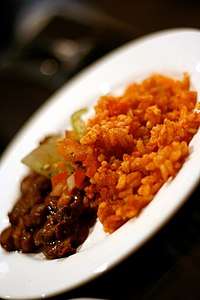Beef brain
Beef brains and veal (juvenile beef) or calf's brains are used in the cuisines of France; Italy; Spain; El Salvador; Mexico, etc. where they are called sesos in Spanish and are eaten in tacos and quesadillas; Pakistan and Bangladesh, where they are known in Urdu and Bengali as Maghaz; Portugal; Indonesia; and in the United States, especially in St. Louis, Missouri, and the Ohio River valley.

Calf's brains, or cervelle de veau, is a traditional delicacy in Europe and Morocco. It is the brain of a calf consumed as meat.[1] It is often served with tongue, sauteed with beurre noir and capers, or mixed with scrambled eggs. In Italy cervella fritte is a popular dish made of bite-sized batter-fried morsels of beef brain. Beef brains have a mushy texture and very little inherent flavor and are typically flavored with sauces such as chile sauce and sauce ravigote.
Outbreaks of bovine spongiform encephalopathy (BSE, commonly known as mad-cow disease) led to legislation to reduce risks of contracting the human variant of the illness by consumption of beef brains and spines.[2][3]
See also
- Brain (as food)
- Cabeza
- Eggs and brains
- Fried-brain sandwich
- Maghaz
- Phospho-Energon
References
- Ward, Artemas (1911). The Grocer's Encyclopedia. New York.
- "The Basics of Mad Cow Disease". WebMD. WebMD LLC. Retrieved 26 June 2018.
- Arthur, Charles (21 March 1996). "The BSE Risk: to eat or not to eat- the facts behind the disease". The Independent. Retrieved 26 June 2018.


.jpg)
